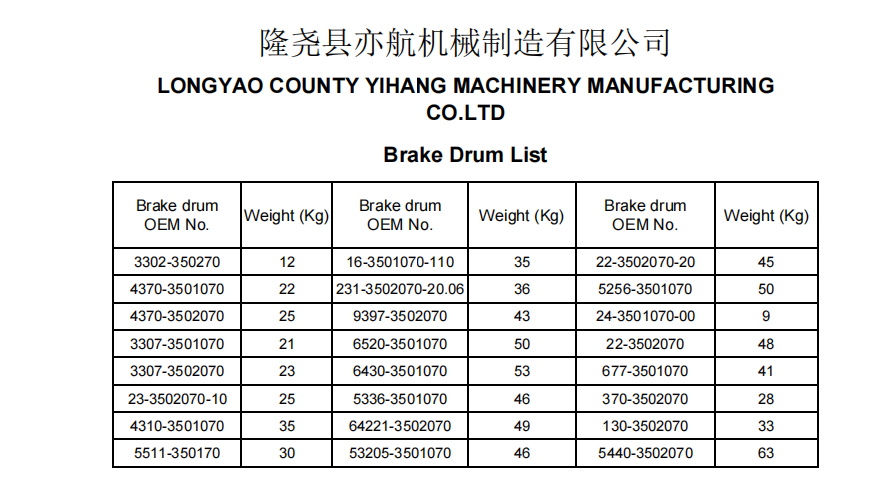Nov . 04, 2024 16:59 Back to list
Understanding Brake Drum Components and Their Importance in Vehicle Safety
Understanding Brake Drums Function, Design, and Maintenance
Brake drums are crucial components in the braking systems of many vehicles, particularly those that utilize a drum brake setup. These devices play a vital role in ensuring the safety of vehicles, enabling efficient stopping power, and providing a smooth driving experience. Understanding brake drums involves exploring their function, design, and maintenance.
Function of Brake Drums
The primary function of a brake drum is to slow down or stop the vehicle by converting kinetic energy into heat through friction. When the driver presses the brake pedal, hydraulic pressure is applied to the brake shoes inside the drum. As the brake shoes expand outward, they make contact with the inner surface of the drum. This friction generates heat and slows the rotation of the wheel, ultimately bringing the vehicle to a halt.
Brake drums are particularly effective in heavy-duty applications, such as trucks and buses, because they can dissipate heat more efficiently than disc brakes. The enclosed design protects the braking mechanism from debris and water, which can contribute to performance consistency in various road conditions.
Design of Brake Drums
Brake drums are typically made from cast iron or aluminum alloy, both of which are chosen for their ability to withstand high temperatures and mechanical stress. The design incorporates a cylindrical shape that houses the brake shoes and is mounted on the wheel hub.
Inside the drum, there are several key features that enhance braking performance. The drum's surface is usually finely machined to provide a smooth contact area for the brake shoes. Additionally, many modern brake drums are produced with venting holes to improve heat dissipation, reducing the risk of brake fade—a condition where brakes become less effective due to overheating.
There is a distinction between standard and self-adjusting brake drums. Self-adjusting drums automatically compensate for wear over time, ensuring optimal brake performance without frequent manual adjustments. This design reduces the maintenance burden on the vehicle owner.
brake drum

Maintenance of Brake Drums
Regular maintenance of brake drums is essential for ensuring safety and performance. Here are some key aspects to consider
1. Inspection Periodic inspections of brake drums should be part of a vehicle's routine maintenance. Technicians look for signs of wear, such as grooves or cracks in the drum surface, which can impair braking efficiency.
2. Cleaning Dust and debris can accumulate inside brake drums, leading to reduced performance. Cleaning the drums and the brake shoes can help maintain optimal friction levels and extend the life of the components.
3. Adjustment For non-self-adjusting drum brakes, it’s essential to check and adjust the brake shoe clearance regularly. Proper alignment ensures that the shoes make adequate contact with the drum, maximizing braking power.
4. Replacement Brake drums should be replaced when they reach the wear limit, which is typically indicated by a machining mark. Neglecting this can lead to severe braking issues and potential safety hazards.
5. Professional Service Depending on the vehicle type and usage, consulting a professional for brake inspections is advisable. They can provide a thorough assessment and suggest necessary services or replacements.
Conclusion
Brake drums are integral to vehicular safety and efficiency. Understanding their function, design, and maintenance can help vehicle owners ensure their braking systems remain in optimal condition. Whether in routine inspection or emergency braking situations, well-maintained brake drums contribute significantly to driving safety and reliability. Always prioritize regular checks and professional assistance to keep your braking system, and hence your vehicle, safe for the road.
-
Volvo Brake Drum: OEM Quality, Optimal Safety
NewsAug.27,2025
-
Durable Brake Drum MAZ for Heavy Duty Trucks | High Performance
NewsAug.26,2025
-
FUWA: Premium Quality, Reliable Performance & Innovative Solutions
NewsAug.25,2025
-
Liza Brake Drum: Superior Quality & Performance for Safe Driving
NewsAug.24,2025
-
Iveco Brake Drum | Premium OE Quality for Daily & Eurocargo
NewsAug.22,2025
-
Your Brake Drum Man: Quality & Performance Parts
NewsAug.21,2025
